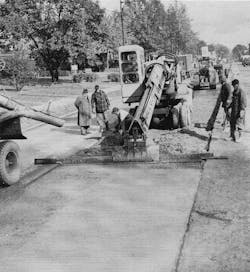Ray and Koop Ferwerda’s Telescopic Excavator
Sometime around 1940, contractors Ray and Koop Ferwerda of Cleveland, Ohio, encountered a situation that required slope work that could only be done manually.
Given the scarcity of labor at the time, something else was needed. They rigged up a primitive hydraulic machine with a blade at the end of a telescopic boom and mounted it to a circle on an old truck. Seeing that they were on to something, they soon redesigned the boom to a triangular cross-section for greater rigidity and added a mechanism to rotate the boom 45 degrees left and right. By 1945, the machine had been designated the Gradall, and excavating buckets were available for it.
The Historical Construction Equipment Association (HCEA) is a 501(c)3 nonprofit organization dedicated to preserving the history of the construction, dredging and surface mining equipment industries. With over 3,800 members in 25 countries, our activities include publication of a quarterly educational magazine, Equipment Echoes, from which this article is adapted; operation of National Construction Equipment Museum and archives in Bowling Green, Ohio; and hosting an annual working exhibition of restored construction equipment. Individual annual memberships are $35 within the U.S. We seek to develop relationships in the equipment manufacturing industry, and we offer a college scholarship for engineering and construction management students. Information is available at www.hcea.net, or by calling 419.352.5616 or emailing [email protected].
The original Gradall embodied principles that have applied to all machines of this type. It moved the attachment along a level plane while still allowing it to pivot up and down through wrist action, and one manufacturer promoted the fully controllable wrist motion as a means of gently loading trucks without shock. Warner & Swasey—which acquired rights to the Gradall in 1945—marketed the machine as replicating the motions of the human hand: in and out, raise and lower, swing, tilt, and flexing at the wrist.
The Gradall also had another advantage over cable backhoes and over hydraulics—a lower vertical clearance, and at the opposite end of the digging cycle. The Gradall’s highest vertical clearance was at the end of the boom when it was at its deepest digging angle, while a backhoe was at the point at which the boom and bucket were lifted clear for dumping. This lower profile enabled it to work in impaired vertical clearances where a backhoe could not, with superior reach as well.
Telescopic excavators also became quite versatile. Where the original ancestor to the Gradall had only a blade, numerous attachments came to be offered: as many as 26 for the M-2460 Gradall, for example. The most common attachments were various sizes of excavating, ditching, and ditch cleaning buckets; a skeleton bucket for prying up concrete slabs or handling riprap; grading and leveling blades like the original machine; a ripper tooth; and straight and gooseneck boom extensions.
Additional attachments were offered for more recent machines. Badger offered air and hydraulic hammers, a “Telestick” backhoe, augers, barrel handler, grapples, crushers, thumb, mower, guardrail cleanout tool, compactor, trencher, and limb shear for its XL series.
Along with grading and excavating, the manufacturers documented or suggested such tasks as sloping at distances from the machine, spreading base course and concrete, pouring concrete in low clearances from a bucket suspended from the boom, supporting a line drill, storm debris cleanup, snow removal, tree clearing, cleaning and maintenance of both sides of a ditch or canal from one position, and slope compaction with a weighted wheel in place of a bucket.
